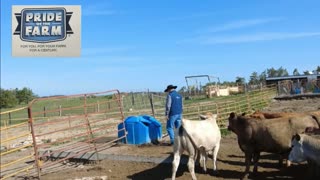Premium Only Content

3 Cotons: The Importance of Follow-Through
It usually doesn’t take long for dog owners to realize that saying commands doesn’t work as much as they wish it did. Simply saying a command to a dog, even a dog with training, does not yield a response every time.
Since dogs don’t have the same abilities as humans, it makes sense that they wouldn’t respond to normal human-like communication. But since we are human, it’s still natural for us to try to get dogs to listen better by repeating ourselves, or even saying commands louder. We know that yelling doesn’t work, but it still happens with a lot of dog owners because we’re human.
What we are doing in training is taking into account the reality of how dogs respond and applying that to our training. Words won’t get you a consistent reliable response, but physical guidance will. Of course, it has to be done with the right technique, but this is where a consistent reliable response is developed.
Physical guidance can be done lots of ways, but there are actually only a few ways that get real results. That’s leash and prong, and ecollar. Physical guidance, done with the right technique) being paired to the verbal commands helps build a more consistent, reliable association for the dog.
This topic must be understood if you’d rather not carry food with you every where you go.
A Dog’s Mindset: The Mental Block
Dog’s are smart, they watch, they learn, they try, they get away with, and they figure out all the holes you have in your system. We may be strict in some areas while not that strict in others. Our dogs learn the specific situations where they are most likely to get away with nonsense behaviors, and they do.
Once we start working through becoming consistent as dog owners, our dogs still have that memory of what they were previously able to get away with. Among these, is the knowledge of opposing the leash (and perhaps everything else you say) to get their way, or at a minimum, not doing what you say.
This is the biggest reason for the need for patience while working through this. Especially with your “sit” and “down” commands. Dogs usually need a little time to mentally sort through the fact that you are actually following through on something you are requiring.
There is usually a specific “newness” to this concept. In a sense, the dog doesn’t believe you when you indicate so they “wait it out”, as if you don’t have it in you to actually follow through. This is where most people will point out that their dog is stubborn. And rightfully so, because before training the dog learned what was and wasn’t allowed. And perhaps, the threshold for good behavior wasn’t set very high.
This is why following through should be your new rule in life. Most folks love to talk about being consistent, but when I ask: “what with?”, I usually hear crickets. Consistency may be the mantra but the details are usually still to be desired. Most know that consistency is key, but I’d say that if you simply follow through on what you say as your way of “being consistent”, you’d be off to a great start.
-
 1:03:30
1:03:30
A Cigar Hustlers Podcast Every Day
1 day agoEpisode 416 Epstein Files w/Matt Booth
9.25K -
 LIVE
LIVE
BEK TV
23 hours agoTrent Loos in the Morning - 11/25/2025
205 watching -
 LIVE
LIVE
The Bubba Army
22 hours agoMAJORIE TAYLOR GREENE QUITS! - Bubba the Love Sponge® Show | 11/25/25
1,462 watching -
 51:11
51:11
ZeeeMedia
15 hours agoBREAKTHROUGH: Nattokinase Dissolves 84% of Amyloid Microclots Within 2 Hours | Daily Pulse Ep 150
31K25 -
 1:12:22
1:12:22
Coin Stories with Natalie Brunell
23 hours agoArnaud Bertrand on Changing World Order: U.S. vs China, Gold, Bitcoin & Dollar Hegemony
26.8K7 -
 40:23
40:23
MetatronHistory
1 day agoI REFUSE To Use BCE/CE And Here is Why
8.07K9 -
 16:00
16:00
Actual Justice Warrior
2 days agoDearborn Muslims Go To WAR With Protesters
11.6K35 -
 16:33
16:33
Code Blue Cam
4 days agoWhen Begging for No Ticket Backfires Immediately
20K21 -
 19:22
19:22
stateofdaniel
4 days agoPresident Trump STRIKES Back Against Democrats Who Encouraged Military to DEFY Him
18.4K10 -
 14:12
14:12
itsSeanDaniel
1 day agoThe Dumbest Liberal in Congress Just EMBARRASSED Herself
19.5K11